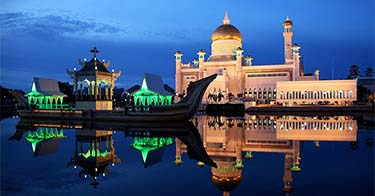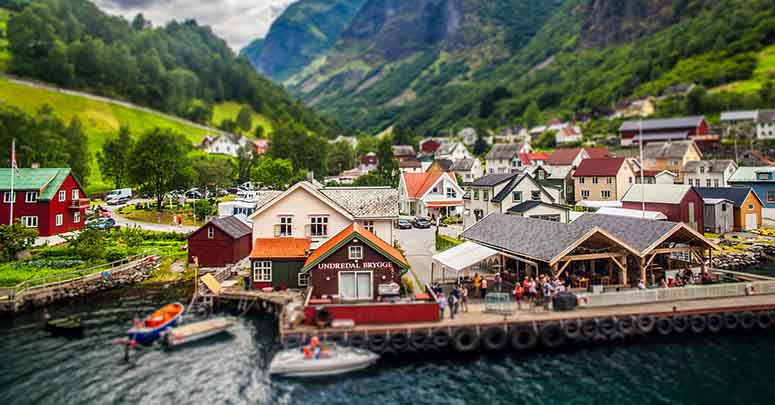Architecture
Ghost Towns In The World - Top 12
Updated March 6, 2019
The world is full of ghost towns! There are completely abandoned cities all around the globe. Towns that has suffered from accidents, wars, financial crises and natural disasters, but still remain, like monuments of the changes of everyday life. Here is our list of the top 12 ghost towns from around the world.
Advertisement:
12. Craco, Italy
Craco is a medieval ghost town in southern Italy. It was built around a thousand years ago on top of a 400 m (1,300 ft) tall cliff.[1]
In the 1960s, the city had 1,800 residents, but recurring earthquakes had taken its toll on both the houses and the cliff.[1]
The city eventually became uninhabitable, mainly because of the many landslides caused by the earthquakes, and the population had to move to another village in 1963.[1] Craco has been abandoned ever since, but several movies have been filmed in the ghost towns' unique environment, such as Mel Gibson's The Passion of the Christ.
11. Sewell, Chile
The colorful city of Sewell it situated high on the slopes of the Andes in Chile, and is one of many abandoned mining towns around the world. The town was founded in 1905 by an American mining company and named after the company's president, Barton Sewell. It was built on top of a rich deposit of copper at an altitude of more than 2,200 m (7,200 ft) and became home for the miners.[2]
Beacuse of the steep slopes, the city had no roads, only stairs and walkways, but the city grew and a total of 15,000 people lived here in 1968.[2]
In the 1970s, the mining company thought it would be more efficient if the workers lived down in the valley, in the city of Rancagua, so Sewell was emptied.[2] Today, Sewell is a ghost town and a UNESCO World Heritage Site. It can be visited with a tour guide.
In the 1970s, the mining company thought it would be more efficient if the workers lived down in the valley, in the city of Rancagua, so Sewell was emptied.[2] Today, Sewell is a ghost town and a UNESCO World Heritage Site. It can be visited with a tour guide.
Advertisement:
10. Agdam, Azerbaijan
Agdam is a big ghost town in Azerbaijan. In 1993, the city was invaded by Armenian-backed forces from Nagorno-Karabakh - a region in Azerbaijan with a majority of Armenians wanting an independent state. Agdam was looted and set on fire, and 100,000 inhabitants became refugees.[3] Today, the city has been broken down by nature. It is still occupied by Armenia.
9. Plymouth, Montserrat
Plymouth is the former capital of the British territory of Montserrat, a beautiful island in the Caribbean. In 1995, the vulcano on Montserrat had a large eruption which covered large parts of the island's southern half, including Plymouth, with lava and ash. Most of the residents were evacuated in time before the city was buried, but 19 people were killed.[4]
The city was abandoned along with the entire southern half of the island. Prior to the eruption, Montserrat had over 10,000 inhabitants, but after the eruption, more than two-thirds of the population left the island, and most have not returned.[4] Plymouth had been the largest city on Montserrat, and almost all of the island's stores and authorities had been located there. Some of the establishments were reinstated elsewehere on the island.
The city was abandoned along with the entire southern half of the island. Prior to the eruption, Montserrat had over 10,000 inhabitants, but after the eruption, more than two-thirds of the population left the island, and most have not returned.[4] Plymouth had been the largest city on Montserrat, and almost all of the island's stores and authorities had been located there. Some of the establishments were reinstated elsewehere on the island.
8. Varosha (Famagusta), Cyprus
Varosha is part of the city of Famagusta on Cyprus, and was a popular tourist destination in the 60s and 70s. In 1974, Cyprus was invaded by Turkey (following an attemptet coup on the island supported by Greece), which led to Varosha being sealed off by the Turks, and all the Greek Cypriots that fled the area were never allowed to return.
Today, Varosha is known as "the ghost town" among tourists, and the only thing moving in the area is Turkish military. On one side of the military fence that surrounds the district lies holidaymakers sunbathing on the beach. On the other side are empty hotels and stores, frozen in time since 1974.
Today, Varosha is known as "the ghost town" among tourists, and the only thing moving in the area is Turkish military. On one side of the military fence that surrounds the district lies holidaymakers sunbathing on the beach. On the other side are empty hotels and stores, frozen in time since 1974.
7. Detroit, USA
To put Detroit on a list of ghost towns might seem surprising, but the fact is that there were around 70,000 abandoned building in the city in 2012.[5] Today, some of these have been demolished or restored, but many of the city's buildings are still abandoned.
Detroit had a population of 1.85 million in 1950 (not counting the suburbs), but that number had decreased to 677,000 in 2015.[6] Today, the population loss has slowed somewhat.[15]
So what has happened in Detroit? Detroit is the center of the U.S. automobile industry and is also known as "Motor City". The large depopulation is mainly a result of financial crises and the fact that many car manufacturers have moved their factories to Asia. Detroit is now struggling with high unemployment and poverty. The photo shows Lee Plaza, once an exclusive apartment building.
So what has happened in Detroit? Detroit is the center of the U.S. automobile industry and is also known as "Motor City". The large depopulation is mainly a result of financial crises and the fact that many car manufacturers have moved their factories to Asia. Detroit is now struggling with high unemployment and poverty. The photo shows Lee Plaza, once an exclusive apartment building.
6. Centralia, USA
The town of Centralia in Pennsylvania, USA had over a thousand residents in 1981. Only seven people live here today.[7]
The reason for this exodus is a fire burning in an abandoned coal mine under the town, spewing poisonous gases into the air.
In 1962, a fire started in the city dump, which spread into the mine. Several attempts to put out the fire failed and it kept on burning in the ground during the 60s and 70s. The fire released toxic substances like hydrogen sulphide, mercury and arsenic, as well as unhealthy amounts of methane, carbon dioxide and carbon monoxide.[8]
In the early 80s, many families lived with carbon monoxide meters in their homes, which alerted when levels became too high.[8] In 1981, a deep sinkhole swirling with toxic gases opened up under 12-year-old Todd as he played in his grandmother's backyard. Hanging on to tree roots, he was pulled to safety by his cousin after 45 s.[8]
The government invoked eminent domain (started buying up all the towns' properties), Centralia's zip code was discontinued and Route 61 that went through the town was blocked with piles of dirt and rerouted. Today, the area mostly looks like overgrown fields, traversed by cracked paved roads. The only indications of the fire burning under the ground are a few smoke plumes rising from cracks on the surface.[8] Only a few houses remain. In 2013, seven people who had refused to move were given permission by the state to live in Centralia for the rest of their lives.[7]
In the early 80s, many families lived with carbon monoxide meters in their homes, which alerted when levels became too high.[8] In 1981, a deep sinkhole swirling with toxic gases opened up under 12-year-old Todd as he played in his grandmother's backyard. Hanging on to tree roots, he was pulled to safety by his cousin after 45 s.[8]
The government invoked eminent domain (started buying up all the towns' properties), Centralia's zip code was discontinued and Route 61 that went through the town was blocked with piles of dirt and rerouted. Today, the area mostly looks like overgrown fields, traversed by cracked paved roads. The only indications of the fire burning under the ground are a few smoke plumes rising from cracks on the surface.[8] Only a few houses remain. In 2013, seven people who had refused to move were given permission by the state to live in Centralia for the rest of their lives.[7]
5. Hashima Island, Japan
Hashima is an island outside the coast of mainland Japan, close to the city of Nagasaki. Its appearance has earned it the nickname "Gunkanjima", which is Japanese for "Battleship Island". Hashima was a coal mine facility owned by Mitsubishi and was inhabited by the miners between the 1890s and 1974. The island had, at most, 5,200 residents in its closely spaced concrete buildings.[9]
When the mine was closed in 1974, the island was left abandoned for 35 years. As the buildings were not maintained, they eventually became in very poor condition, and several of them have collapsed. In 2009, parts of Hashima were opened for tourism. Scenes in the James Bond movie Skyfall were filmed here.
When the mine was closed in 1974, the island was left abandoned for 35 years. As the buildings were not maintained, they eventually became in very poor condition, and several of them have collapsed. In 2009, parts of Hashima were opened for tourism. Scenes in the James Bond movie Skyfall were filmed here.
4. Beichuan, China
The city of Beichuan in China was one of the places hit hardest by the 2008 Sichuan earthquake. The earthquake had a magnitude of 7.9,[10] and killed nearly 90,000 people in the Sichuan province.[11]
In Beichuan, lots of buildings collapsed, and many people were killed. Instead of rebuilding the city, the authorities decided that the entire city of Beichuan would be a memorial site.
The survivors was relocated and the buildings stabilized. Today, Beichuan is a ghost town as well as a place where survivors, relatives of the victims and tourists can travel to reflect on the disaster.
3. Pripyat, Ukraine
Pripyat in northern Ukraine is perhaps the most famous of all the world's abandoned cities. Pripyat once had 30,000 residents,[12] of which many worked at the nearby nuclear power plant Chernobyl.
On April 26, 1986, one of the reactors in the power plant exploded, and a cloud of radioactive particles spread over large parts of Europe.
The next day, the people of Pripyat were informed that the radioactivity levels were rising and that they temporarely had to evacuate.
They did not know then, that they would never be allowed return.
Pripyat is now a looted and vandalized ghost town that can be visited by tourists with a guide and permit. The city is slowly being taken over by nature and the area might not be habitable for centuries (although it's safe to spend shorter periods of time there). The photo shows Chernobyl from one of the rooftops in Pripyat.
Pripyat is now a looted and vandalized ghost town that can be visited by tourists with a guide and permit. The city is slowly being taken over by nature and the area might not be habitable for centuries (although it's safe to spend shorter periods of time there). The photo shows Chernobyl from one of the rooftops in Pripyat.
2. Oradour-Sur-Glane, France
Oradour-sur-Glane was a town in France that fell victim to one of the most horrific events of the Second World War.
On June 10, 1944, four days after the D-day, 200 German Waffen-SS soliders marched into the village and gathered all 652 inhabitants in the towns square.[13] As vengeance for an earlier attack by the French Resistance, all the towns' men were locked in a barn, while all women and children were locked in the church.[13]
The German soldiers set the entire town on fire, and those inhabitants who did not choke or burned to death were killed by machine guns or grenades. A total of 642 inhabitants were murdered, of whom 245 were women and 207 were children.[13] Somehow, 10 people managed to survive.
A new village with the same name was built after the war, just next to the old one. The war-torn ruins were left standing as a reminder of the terrible massacre, and are today a popular tourist destination. Of all the abandoned towns in the world, Oradour-sur-Glane is definitely one of the most ghostly.
A new village with the same name was built after the war, just next to the old one. The war-torn ruins were left standing as a reminder of the terrible massacre, and are today a popular tourist destination. Of all the abandoned towns in the world, Oradour-sur-Glane is definitely one of the most ghostly.
1. Kowloon Walled City, Hong Kong
Kowloon Walled City was a district in Hong Kong, and one of the most densely populated places on Earth. In a way, Kowloon Walled City doesn't fit onto a list of ghost towns since it no longer exists (it was demolished in 1994) and before that, it was never abandoned by people. But Kowloon Walled City was a ghost town in the sense that is was abandoned by the government and authorities.
The weird story began in 1898, when China gave the entire Hong Kong area to the Brits, except a small area where the Chinese had a small military village surrounded by a wall.[14] The Chinese got to keep "the Walled City" until the details of its rule were settled, so the area became an enclave, that is, an area belonging to one country (China) completely surrounded by another country (Great Britain). However, the British made several attempts to empty the city, and in 1899, they announced that the military village did indeed belong to them, which led to the Chinese leaving the area.[14] The Brits then left the area relatively untouched and the buildings began to decay.
The weird story began in 1898, when China gave the entire Hong Kong area to the Brits, except a small area where the Chinese had a small military village surrounded by a wall.[14] The Chinese got to keep "the Walled City" until the details of its rule were settled, so the area became an enclave, that is, an area belonging to one country (China) completely surrounded by another country (Great Britain). However, the British made several attempts to empty the city, and in 1899, they announced that the military village did indeed belong to them, which led to the Chinese leaving the area.[14] The Brits then left the area relatively untouched and the buildings began to decay.
During World War II, Hong Kong was occupied by Japan, who tore down the old wall to get building blocks for the expansion of the nearby Kai Tak Airport.[14]
After the Japanese surrender in 1945, Chinese refugees moved into Kowloon Walled City. In 1947, 2,000 people lived here, new houses were built, and in 1971 the population in the district had risen to 10,000.[14] The photo above is from 1975.
Kowloon Walled City became a politically sensitive land area - a kind of no-man's land - that the British did not want to touch because it could damage the relations with China.[14] Instead, running the town were groups of criminals within the notorious crime syndicate the Triads. Crime, drugs and prostitution flourished in the town, but here were also ordinary folks living their daily lives, going to school and working.[14] In the lawless district, self-appointed dentists were able to open up practices, and grocery stores and small factories got zero visits from health inspectors.[14]
Kowloon Walled City became a politically sensitive land area - a kind of no-man's land - that the British did not want to touch because it could damage the relations with China.[14] Instead, running the town were groups of criminals within the notorious crime syndicate the Triads. Crime, drugs and prostitution flourished in the town, but here were also ordinary folks living their daily lives, going to school and working.[14] In the lawless district, self-appointed dentists were able to open up practices, and grocery stores and small factories got zero visits from health inspectors.[14]
During the following decades, there was construction in all directions (there were hardly any building laws), and the buildings were eventually so close to each other that the sun barely reached the ground - sometimes there was not even space enough to open a window. When there was no empty land space left, houses were built on top of each other, until the whole area looked like stacked shoe boxes. In the late 80s, a total of 35,000 people lived within the tiny district.[14]
In 1987, the British decided that they could no longer ignore the area. Although Hong Kong provided some services to Kowloon Walled City, such as water supply and mail delivery, the Brits could no longer accept the lawless district with its substandard living conditions. After an arduous eviction process, the demolition of Kowloon Walled City was completed in 1994.[14] Today, the site is home to a beautiful park, where parts of the old buildings have been preserved, to remind us of one of the strangest places that ever existed.
In 1987, the British decided that they could no longer ignore the area. Although Hong Kong provided some services to Kowloon Walled City, such as water supply and mail delivery, the Brits could no longer accept the lawless district with its substandard living conditions. After an arduous eviction process, the demolition of Kowloon Walled City was completed in 1994.[14] Today, the site is home to a beautiful park, where parts of the old buildings have been preserved, to remind us of one of the strangest places that ever existed.
References
[1]
"Basilicata & Craco". The Craco Society. Retrieved March 6, 2019.
[2]
"Sewell Mining Town". UNESCO. Retrieved March 6, 2019.
[3]
"Caucasus City Falls to Armenian Forces". The New York Times. Published Aug 24, 1993. Retrieved March 6, 2019.
[4]
"Montserrat". Encyclopedia Britannica. Retrieved March 6, 2019.
[5]
"How Detroit Became the World Capital of Staring at Abandoned Old Buildings". The New York Times Magazine. Published Nov 9, 2012. Retrieved March 6, 2019.
[6]
"Detroit population rank is lowest since 1850". The Detroit News. Published May 19, 2016. Retrieved March 6, 2019.
[7]
"Agreement Reached With Remaing Centralia Residents". WNEP. Published Nov 30, 2013. Retrieved March 6, 2019.
[8]
"Pictures: Centralia Mine Fire, at 50, Still Burns With Meaning". National Geographic. Published Jan 2013. Retrieved March 6, 2019.
[9]
"Ha Island". Encyclopedia Britannica. Retrieved March 6, 2019.
[10]
"World - M7+ in 2008". USGS. Retrieved March 6, 2019.
[11]
"Sichuan earthquake of 2008". Encyclopedia Britannica. Retrieved March 6, 2019.
[12]
"Chernobyl disaster". Encyclopedia Britannica. Retrieved March 6, 2019.
[13]
"Oradour-sur-Glane". Encyclopedia Britannica. Retrieved March 6, 2019.
[14]
"Kowloon Walled City: Life in the City of Darkness". South China Morning Post. Updated Feb 12, 2015. Retrieved March 6, 2019.
[15]
"Detroit's population loss slows, but rebound elusive ". The Detroit News. Published May 24, 2018. Retrieved March 6, 2019.
Related
Latest


















































